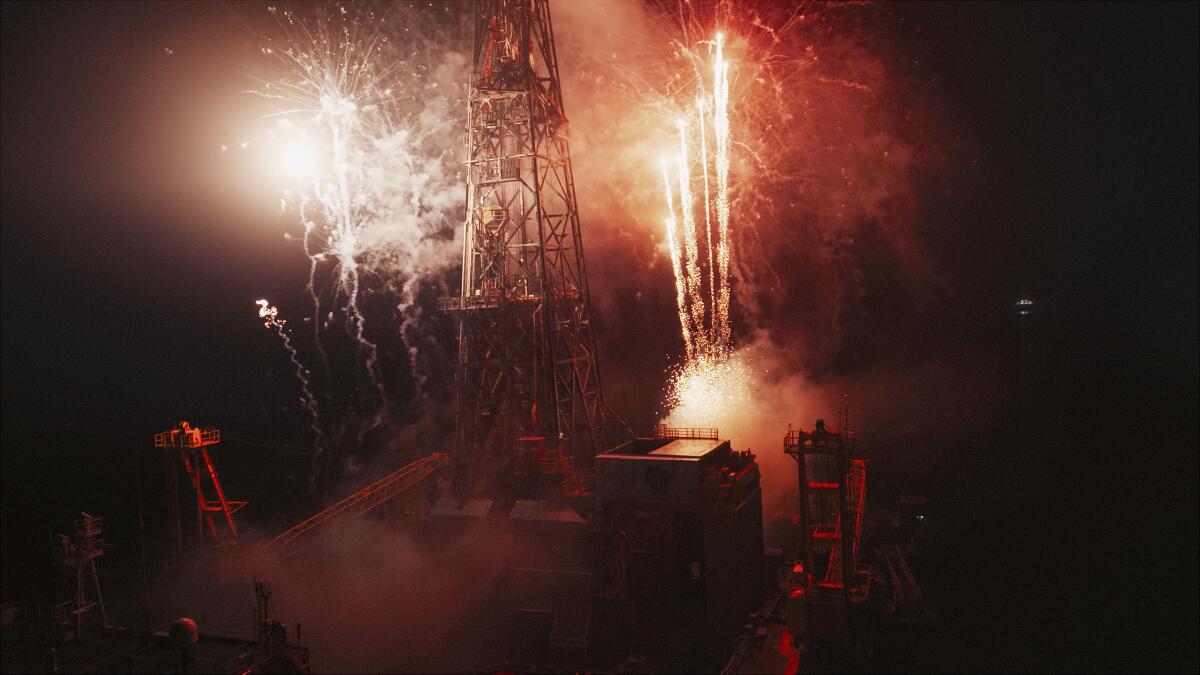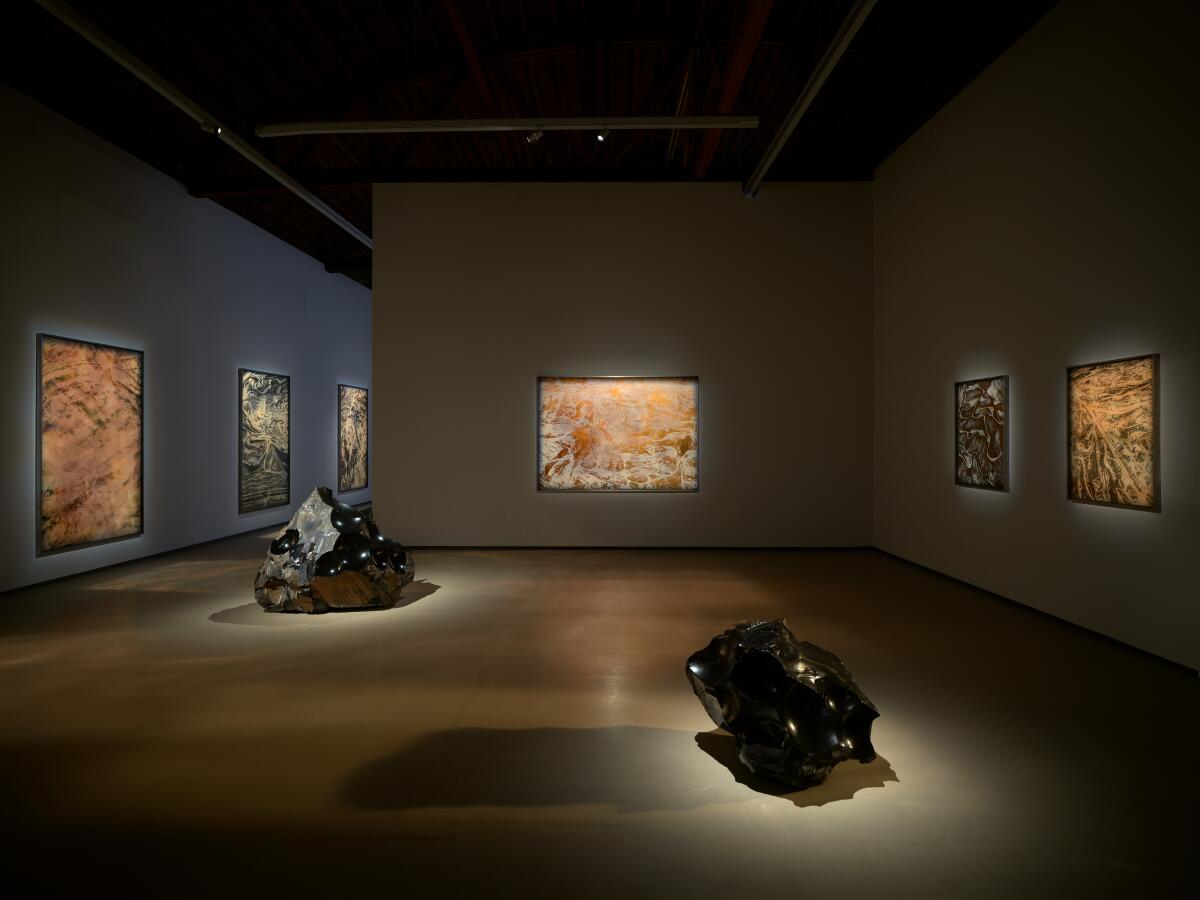Blockbuster beauty and epic disaster intertwine in Julian Charrière’s art

- Share via
The visual choreography in “Controlled Burn,” a mural-scale video installation of elaborate pyrotechnics by Julian Charrière, transforms light-filled bursts of pinwheel energy into a mesmerizing dance of death. The projection at Sean Kelly Gallery runs on a 32-minute loop, and it’s hard to look away.
Energy is the work’s topical subject. Blockbuster beauty and epic disaster intertwine.
Tiny spots of bright, white light speckling a jet black field suggest a placid night sky. The spots begin to move, and slip-sliding traceries of luminosity explode. Smoke-shrouded rockets suddenly collapse into themselves, as if overheated galaxies crumpling into icy black holes. The soundtrack’s low rumble swells into a roar, while a quick dusty glimpse of desert floor in glowing raw sienna slams the boundless sky into the circumscribed earth. The noise subsides.
Then it’s off again, soaring through a gorgeous black and white fireworks display, an optical outtake as if from a fantasy Fourth of July, until a collapsing tower of rusted metal momentarily thrusts into view among shooting stars. Perhaps a rotting oil derrick, it could well be at the bottom of a poisoned sea.
Charrière filmed these swooping, looping aerial scenes with a drone at open pit mines and oil drilling sites rigged with fireworks, then edited them into a measured composition with studied theatrical skill. Running clips forward and backward at variable speeds creates a dizzying apocalypse of explosion and implosion. A gallery handout says “flashing images of primordial unfurling ferns and fluttering moths” appear at subliminal speed, but I didn’t see them. (Such is subliminal perception.) No matter: The Swiss-born, Berlin-based artist has marshaled a lucid tone poem on energy as both fruitful power and injurious force. (Watch a clip of “Controlled Burn” here.)

The impressive exhibition — titled “Buried Sunshine,” a familiar description at once radiant and funerary — is Charrière’s Los Angeles debut. He localized the visually extravagant 2022 video projection with eight large new photographs, plus two sculptures from 2020. The pictures record L.A. and vicinity, the sculptures connect to Mesoamerican material culture.
The photographs are made using heliography — “sun writing,” a term coined by 19th century French photography pioneer Nicéphore Niépce — a technique akin to etching with light-sensitive materials on reflective pewter plates. Instead of pewter, Charrière employs polished stainless steel panels, the largest more than seven feet tall. The plates are treated with a light-sensitive emulsion that incorporates bitumen asphalt that the artist gathered from Southern California tar pits — La Brea, McKittrick and Carpinteria — and printed with aerial photographic views of regional oil fields, past and present.
The imagery is virtually abstract. The landscape being mapped goes in and out of view, swirls of color melting into urban street grids, hills flattening into patterned ripples. Color is a bilious miasma, golden tones sliding into flashes of brightness that collapse into queasy hues. The work is spotlighted in darkened galleries, which enhances the qualities of reflection in the metal plates, but it also interferes with close scrutiny. I wondered what the heliographs would look like in ordinary daylight.
Two sculptures are massive chunks of black obsidian, a glassy volcanic rock formed deep underground and a material found at many Mesoamerican archaeological sites. (It had both utilitarian and ritual uses.) They are titled with a suggested narrative: “Thickens, pools, rushes, slows.” Obsidian is a primordial ooze, its natural history connected to the heliographs and the projection. With portions carved as rounded bumps and curving hollows, the shiny forms make a sly visual connection with the bubbling asphalt surface at the La Brea Tar Pits.
Charrière underscores cultural attraction as modern amusement, catastrophe be damned. In a precarious balancing act, he doesn’t pretend that either the ecological ruin or the pleasure isn’t real, instead articulating the anxious dilemma. Today, L.A.’s once-massive oil fields are mostly a memory, retained in archival photographs. But the memory is etched into daily life, as surely as it is in Charrière’s startling heliography.
"Buried Sunshine"
Where: Sean Kelly Gallery, 1357 N. Highland Ave., Hollywood
When: Through Nov. 4. 11 a.m.-6 p.m. Tuesdays-Friday, 10 a.m.-6 p.m. Saturdays
Info: (310) 499-0843, www.skny.com
More to Read
The biggest entertainment stories
Get our big stories about Hollywood, film, television, music, arts, culture and more right in your inbox as soon as they publish.
You may occasionally receive promotional content from the Los Angeles Times.











